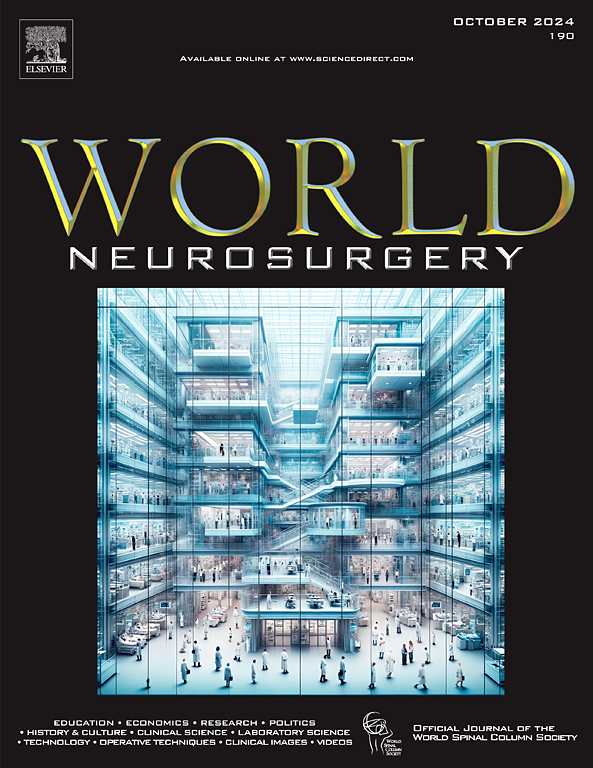Machine Learning Algorithms for Neurosurgical Preoperative Planning: A Scoping Review
IF 1.9
4区 医学
Q3 CLINICAL NEUROLOGY
引用次数: 0
Abstract
Background and Objective
Preoperative neurosurgical planning is an important step in avoiding surgical complications, reducing morbidity, and improving patient safety. The incursion of machine learning (ML) in this domain has recently gained attention, given the notable advantages in processing large datasets and potentially generating efficient and accurate algorithms in patient care. We explored the evolving applications of ML algorithms in the preoperative planning of brain and spine surgery.
Methods
In accordance with the Arksey and O'Malley framework, a scoping review was conducted using 3 databases (PubMed, Embase, and Web of Science). Articles that described the use of ML for preoperative planning in brain and spine surgery were included. Relevant data were collected regarding the neurosurgical field of application, patient baseline features, disease description, type of ML technology, study's aim, preoperative ML algorithm description, and advantages and limitations of ML algorithms.
Results
Our search strategy yielded 7407 articles, of which 8 studies (5 retrospective, 2 prospective, and 1 experimental) satisfied the inclusion criteria. Clinical information from 518 patients (62.7% female; mean age: 44.8 years) was used for generating ML algorithms, including convolutional neural networks (14.3%), logistic regression (14.3%), and random forest (14.3%), among others. Neurosurgical fields of applications included functional neurosurgery (37.5%), tumor surgery (37.5%), and spine surgery (25%). The main advantages of ML included automated processing of clinical and imaging information, selection of an individualized patient surgical approach, and data-driven support for treatment decision-making. All studies reported technical limitations, such as long processing time, algorithmic bias, limited generalizability, and the need for database updating and maintenance.
Conclusions
ML algorithms for preoperative neurosurgical planning are being developed for efficient, automated, and safe treatment decision-making. However, future studies are necessary to validate their objective performance across diverse clinical scenarios. Enhancing the robustness, transparency, and understanding of ML applications will be crucial for their successful integration into neurosurgical practice.
神经外科术前规划的机器学习算法:综合范围综述。
背景和目的:术前神经外科规划是避免手术并发症、降低发病率和提高患者安全性的关键一步。鉴于机器学习(ML)在处理大型数据集和在患者护理中生成高效准确算法方面的显著优势,机器学习在这一领域的应用最近受到了关注。在此,我们评估了 ML 算法在脑部和脊柱手术术前规划中不断发展的应用:根据 Arksey 和 O'Malley 框架,我们使用三个数据库(Pubmed、Embase 和 Web of Science)进行了范围界定审查。纳入了描述在脑部和脊柱手术中使用 ML 进行术前规划的文章。收集的相关数据涉及神经外科应用领域、患者基线特征、疾病描述、ML 技术类型、研究目的、术前 ML 算法描述以及 ML 算法的优势和局限性:我们的搜索策略获得了 7,407 篇文章,其中 8 项研究(5 项回顾性研究、2 项前瞻性研究和 1 项实验研究)符合纳入标准。518名患者(62.7%为女性;平均年龄:44.8岁)的临床信息被用于生成ML算法,包括卷积神经网络(14.3%)、逻辑回归(14.3%)、随机森林(14.3%)和其他算法。神经外科应用领域包括功能神经外科(37.5%)、肿瘤外科(37.5%)和脊柱外科(25%)。ML 的主要优势包括自动处理临床和成像信息、选择个性化的患者手术方法以及为治疗决策提供数据驱动支持。所有研究都报告了技术上的局限性,如处理时间长、算法偏差、通用性有限以及需要更新和维护数据库:结论:目前正在开发用于术前神经外科规划的 ML 算法,以实现高效、自动化和安全的治疗决策。增强 ML 应用的稳健性、透明度和理解力对其成功融入神经外科实践至关重要。
本文章由计算机程序翻译,如有差异,请以英文原文为准。
求助全文
约1分钟内获得全文
求助全文
来源期刊

World neurosurgery
CLINICAL NEUROLOGY-SURGERY
CiteScore
3.90
自引率
15.00%
发文量
1765
审稿时长
47 days
期刊介绍:
World Neurosurgery has an open access mirror journal World Neurosurgery: X, sharing the same aims and scope, editorial team, submission system and rigorous peer review.
The journal''s mission is to:
-To provide a first-class international forum and a 2-way conduit for dialogue that is relevant to neurosurgeons and providers who care for neurosurgery patients. The categories of the exchanged information include clinical and basic science, as well as global information that provide social, political, educational, economic, cultural or societal insights and knowledge that are of significance and relevance to worldwide neurosurgery patient care.
-To act as a primary intellectual catalyst for the stimulation of creativity, the creation of new knowledge, and the enhancement of quality neurosurgical care worldwide.
-To provide a forum for communication that enriches the lives of all neurosurgeons and their colleagues; and, in so doing, enriches the lives of their patients.
Topics to be addressed in World Neurosurgery include: EDUCATION, ECONOMICS, RESEARCH, POLITICS, HISTORY, CULTURE, CLINICAL SCIENCE, LABORATORY SCIENCE, TECHNOLOGY, OPERATIVE TECHNIQUES, CLINICAL IMAGES, VIDEOS
 求助内容:
求助内容: 应助结果提醒方式:
应助结果提醒方式:


